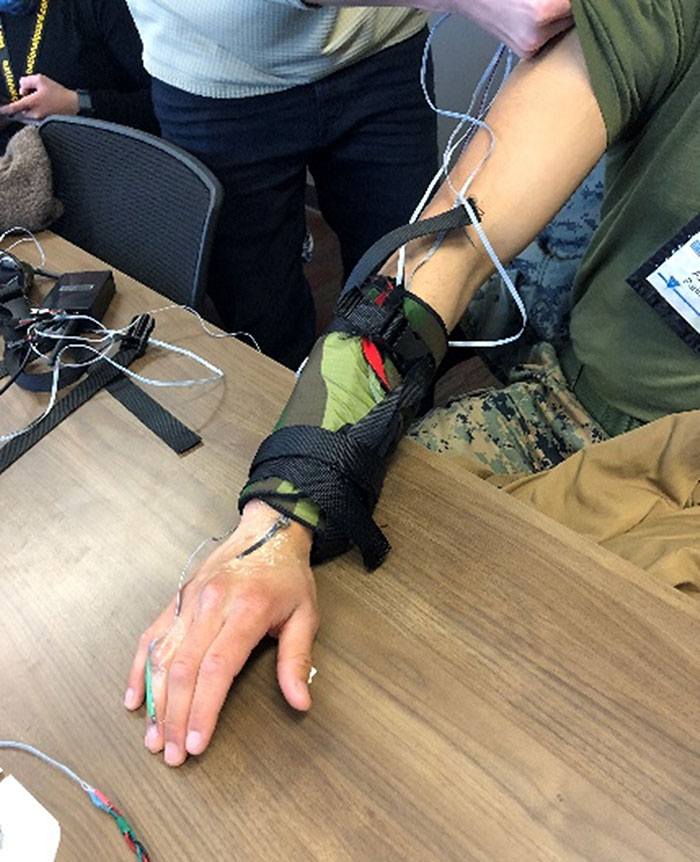MRDC Product Transitions Aid, Impact the Warfighter

John Castellani got the breakthrough he was looking for after about a decade. As a research physiologist at the U.S. Army Medical Research and Development Command's Research Institute of Environmental Medicine, he'd been trying to develop a way to make freezing temperatures somehow feel less cold for Soldiers operating in frigid conditions; his main concern being those tasked with performing medical procedures.
"One of the biggest problems that Warfighters – and most everybody else – can understand is that when you're working in cold weather, you lose the ability to use your hands fairly quickly," says Castellani, the deputy division chief at USARIEM's Thermal and Mountain Medicine Division, noting that both manual dexterity and tactile sensitivity decrease substantially in such weather. "If we can keep those areas warm, we're going to have fewer injuries, better performance and a Warfighter who's going to be more lethal."
Building upon an idea that had been gestating since 2012, Castellani developed and then tested a prototype heated arm sleeve earlier this year in Alaska that was ultimately found to boost manual dexterity by up to 50 percent in some cases. The product, called the Personal Heating Dexterity Device, is powered via battery and worn solely around the forearm (negating the need for gloves), has since been transferred to the MRDC Warfighter Health, Protection and Evacuation Program Management Office. The effort stands as one of a handful of notable product transitions for the command during the current year; fortifying MRDC's contributions to the resiliency of the Warfighter.
A transition agreement is, in short, the official transfer of either a knowledge or materiel product from MRDC's various research entities to one of the command's acquisition arms. In Castellani's case, the work he and his team performed at USARIEM – including the creation of a prototype and the collection of key data – was then picked up by the WHPE PMO for the purposes of further developing the product. His heated forearm sleeve is one of the five total products for which MRDC has secured transition agreements this year.
"These transition agreements are intended to document that, yes, we have done our part of the job in the science and technology area, and that we have provided what we said we would provide to the particular acquisition program to carry the ball from there," says Mark Dertzbaugh, Principal Assistant for Research and Technology at MRDC.
Dertzbaugh says senior leadership at the U.S. Department of Defense recently expressed greater interest in the command's delivery of solutions specific to the Warfighter. That request has, in turn, spurred renewed attention as to how exactly those solutions are – as Dertzbaugh says – "pushed across the goal line." The answer, in short, is teamwork.
"Teamwork is absolutely critical," says Stefan Pasiakos, chief of the Military Performance Division at USARIEM. "If we didn't actively pursue and engage with our stakeholders and customers, they wouldn't know the kind of work we're doing – and additionally, it would be far less likely that our science would impact the Warfighter."
Pasiakos and his team recently closed out a transition agreement for a knowledge product focused on what he calls "biomedical performance enhancement interventions" for the special operations community. Specifically, Pasiakos' team found that providing safe doses of testosterone to study participants during simulated strenuous operations can help prevent muscle loss during catabolic stress. After conducting a pair of randomized trials, this knowledge product was then delivered per a transition agreement (via a scientific paper) to the U.S. Special Operations Command.
The process for developing a transition agreement contains a number of key steps, according to Steve Hawbecker, a project manager at the WPHE PMO. Following the completion of efforts on the science and technology side, product developers transition the given product to a Program of Record. However, this step can only occur if funding is aligned within the Program Objective Memorandum. At that point, a Capability Development Document must be approved, and then an acquisition strategy developed. After that, the product developer finalizes the design, completes packaging and prepares a life cycle support plan. This step also includes the preparation of funding for sustainment as well as the completion of developmental and operational testing. These processes are then codified in the Joint Capabilities Integration and Development System.

"Teamwork on the agreement between the science and technology side and the product development side is essential to a seamless transition to include the alignment of funding, product development continuation and test scenarios and scheduling," says Hawbecker.
From his perspective, Pasiakos too notes the importance of unified effort; a transition agreement needs to be developed early in the process – a requirement which essentially dictates the need for an engaged and energetic partner (the party which will ultimately receive the product in question). Early involvement also increases the flow of information between the parties, allowing each to determine what the final deliverable will be, and the deadlines for those deliverables.
"From an informational standpoint, our work on this knowledge product is a good example of getting a product where it needs to go," says Pasiakos, who's been at USARIEM for 14 years. "And it's definitely a team effort because it requires people on our end here, our legal review team, MRDC's component of that, and then making sure that information gets to right people."
For Castellani, too, that's the most important part of this lengthy process: ensuring that the right information is funneled to the right people in order to make the greatest impact. It is a simple, yet powerful, plan.
Says Castellani, "I just want to get the right products out to the Soldier so that they can do their jobs better in these extreme environments."















